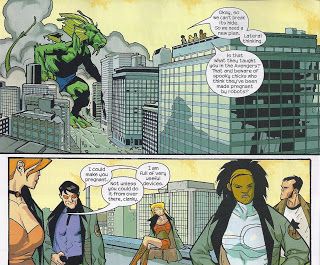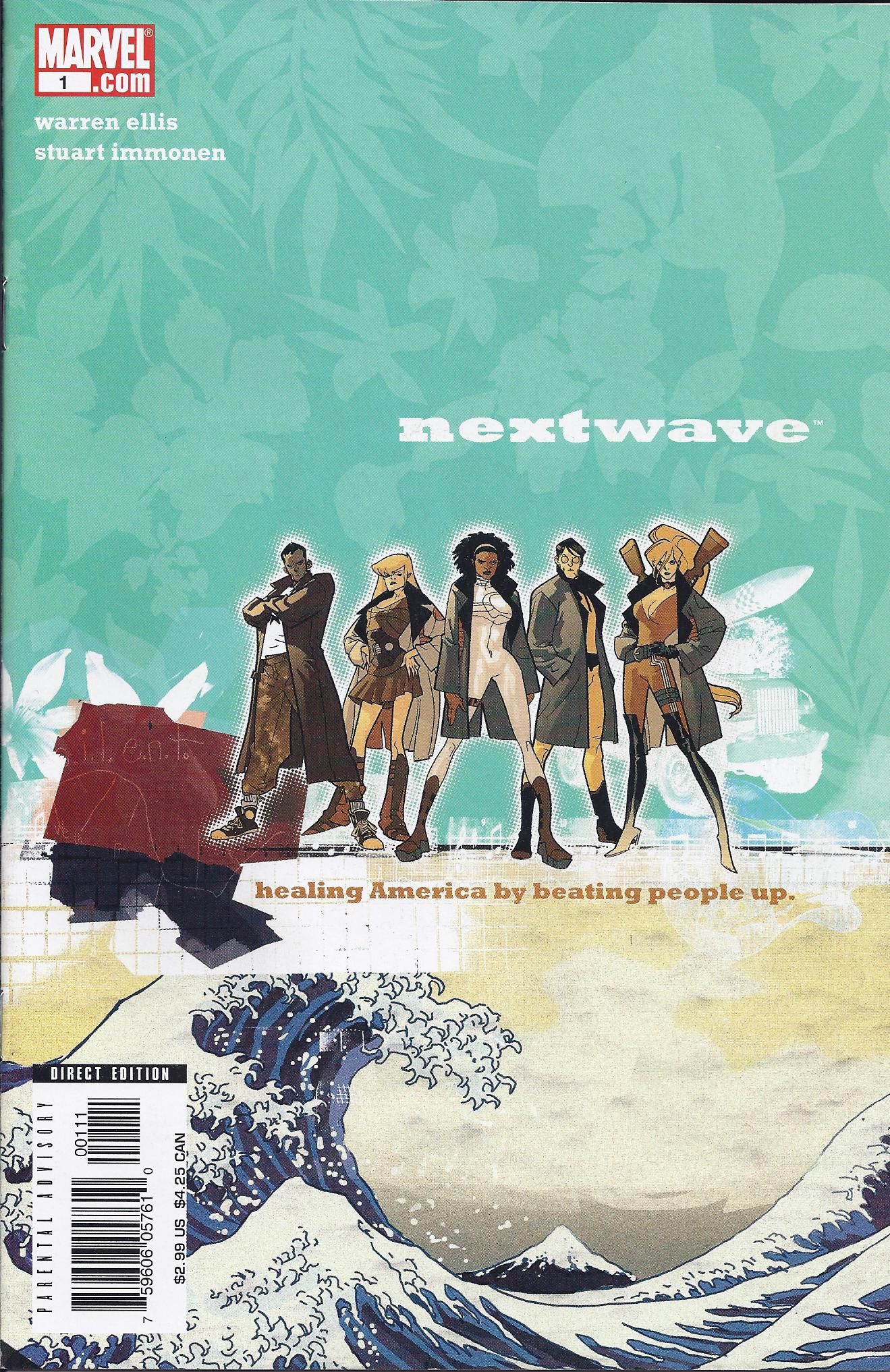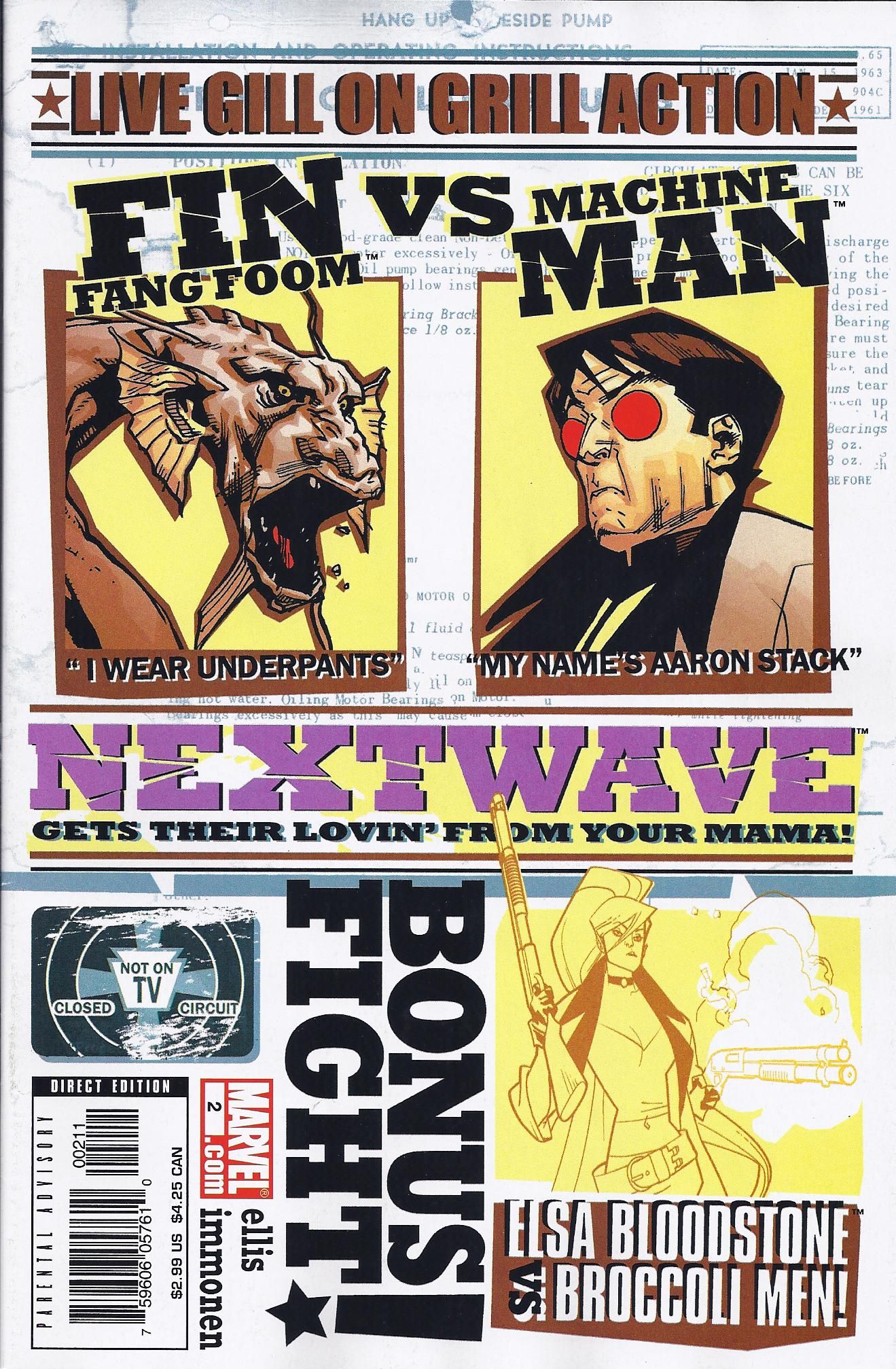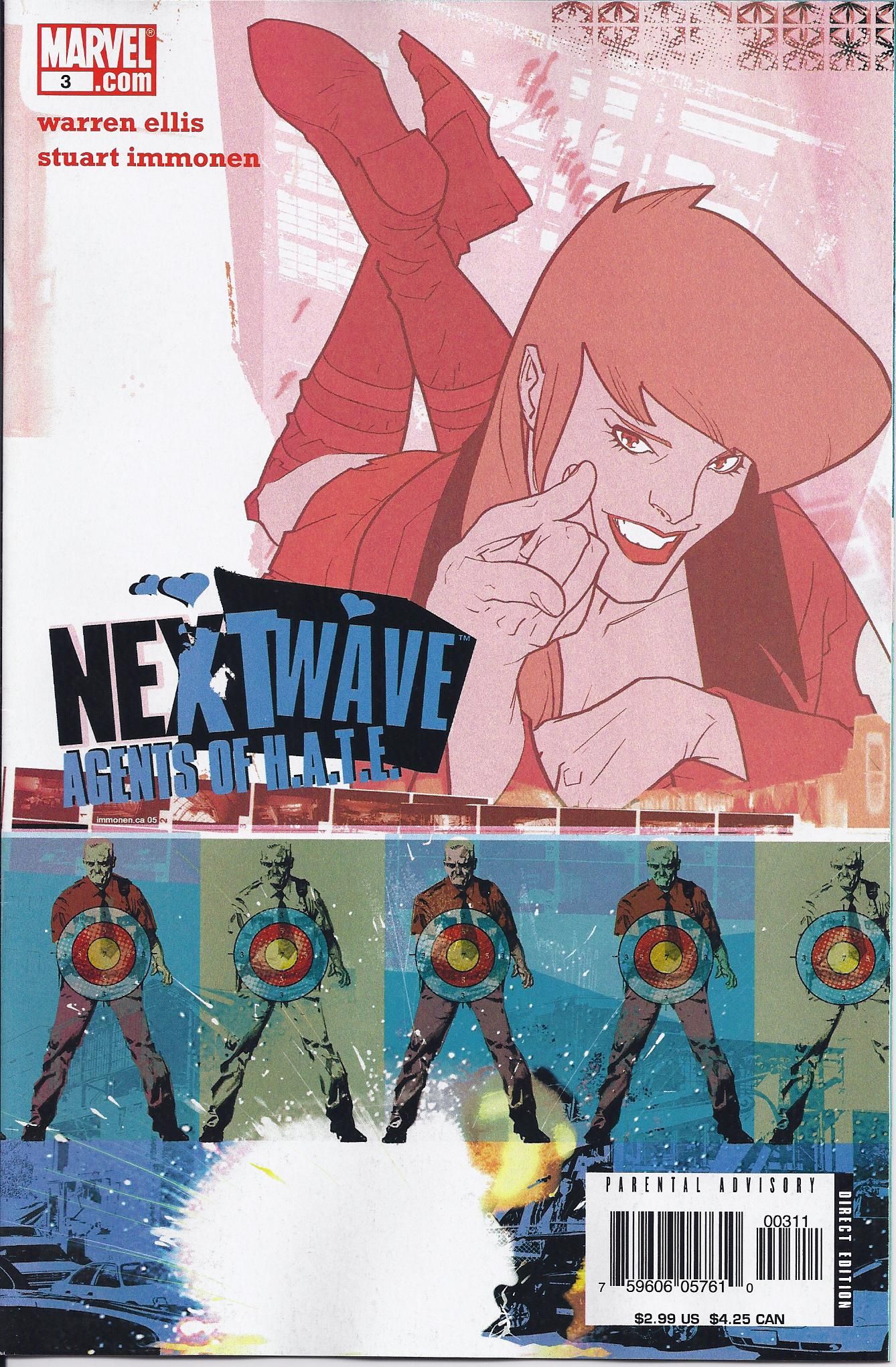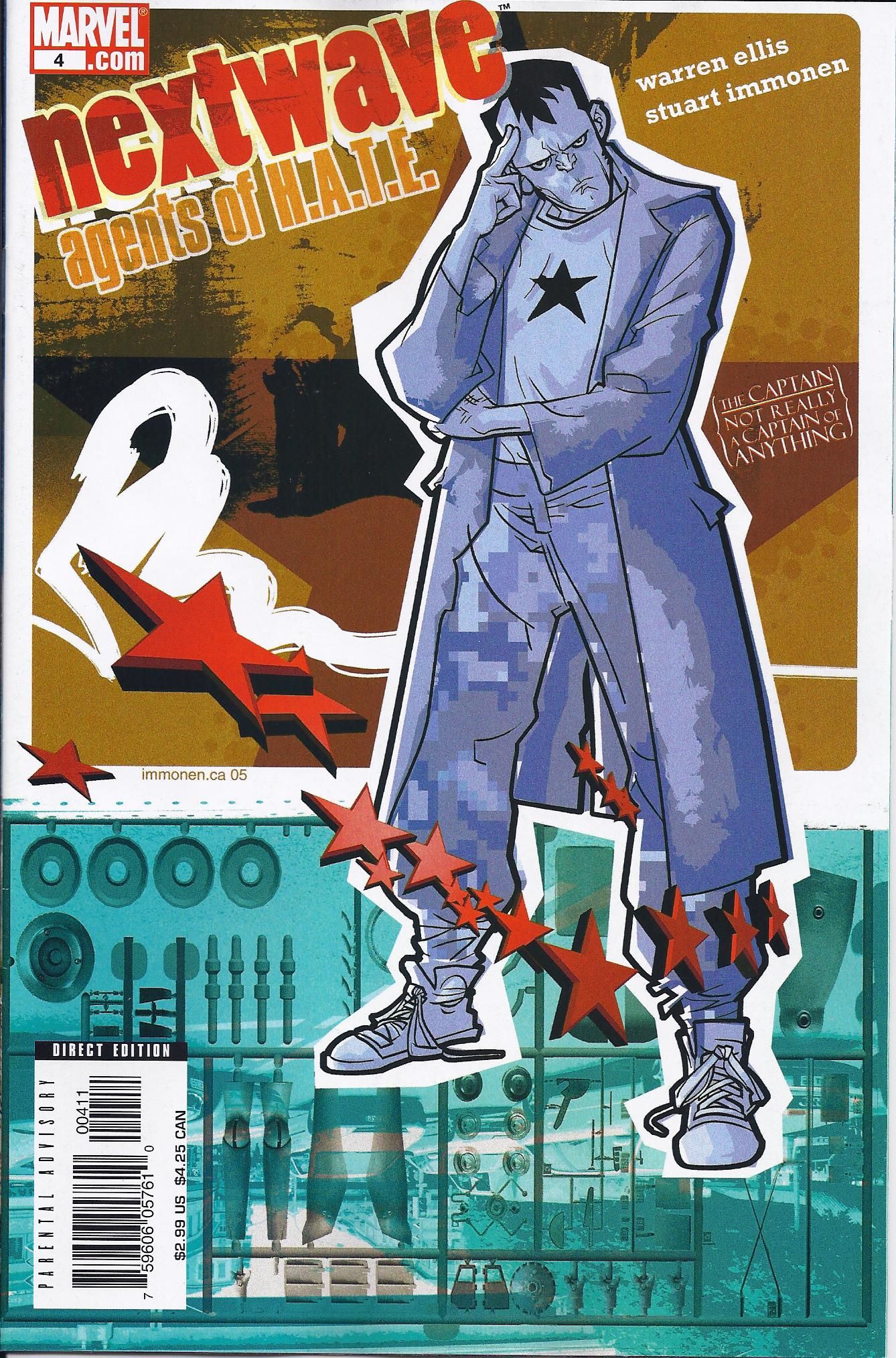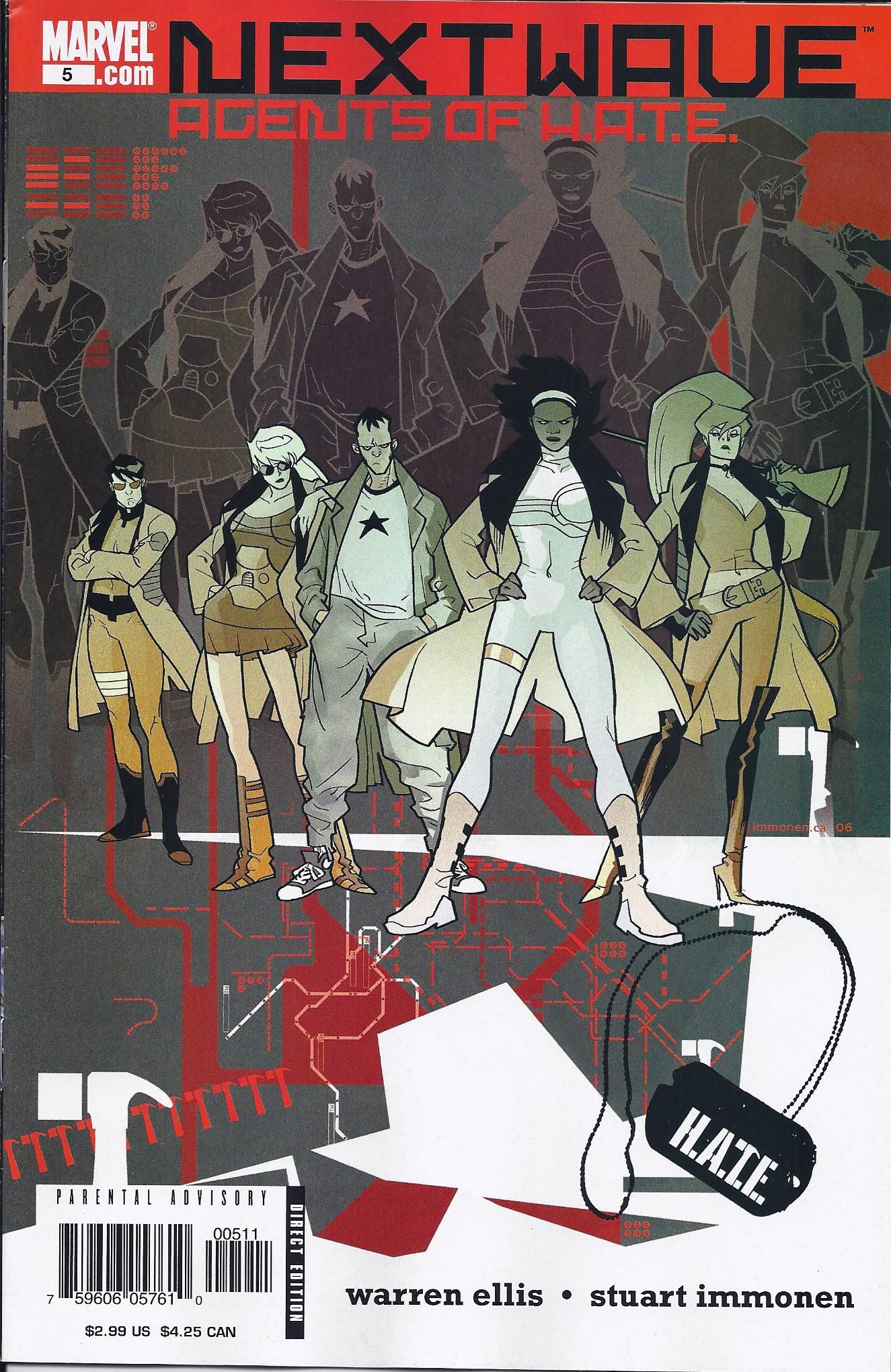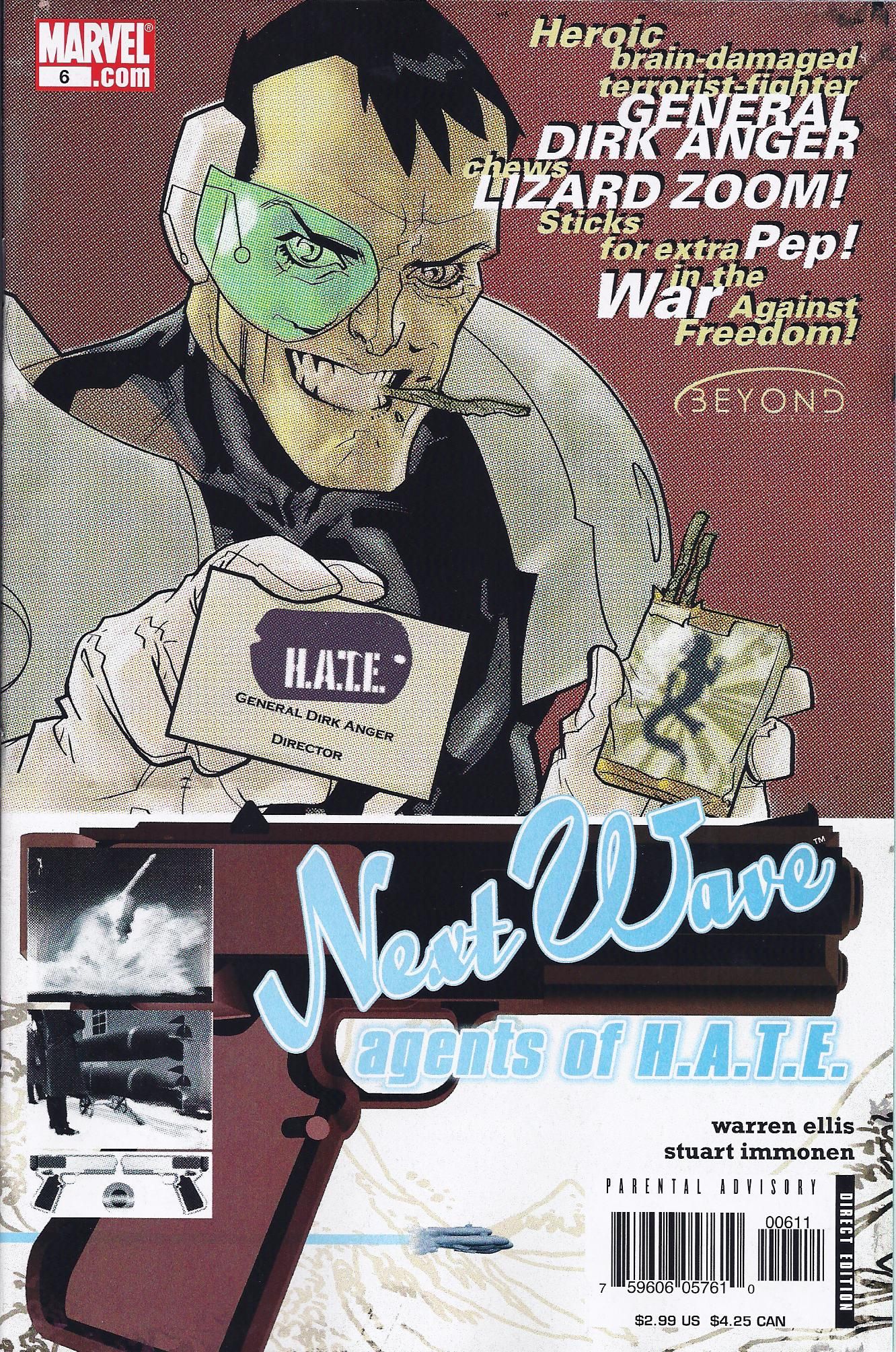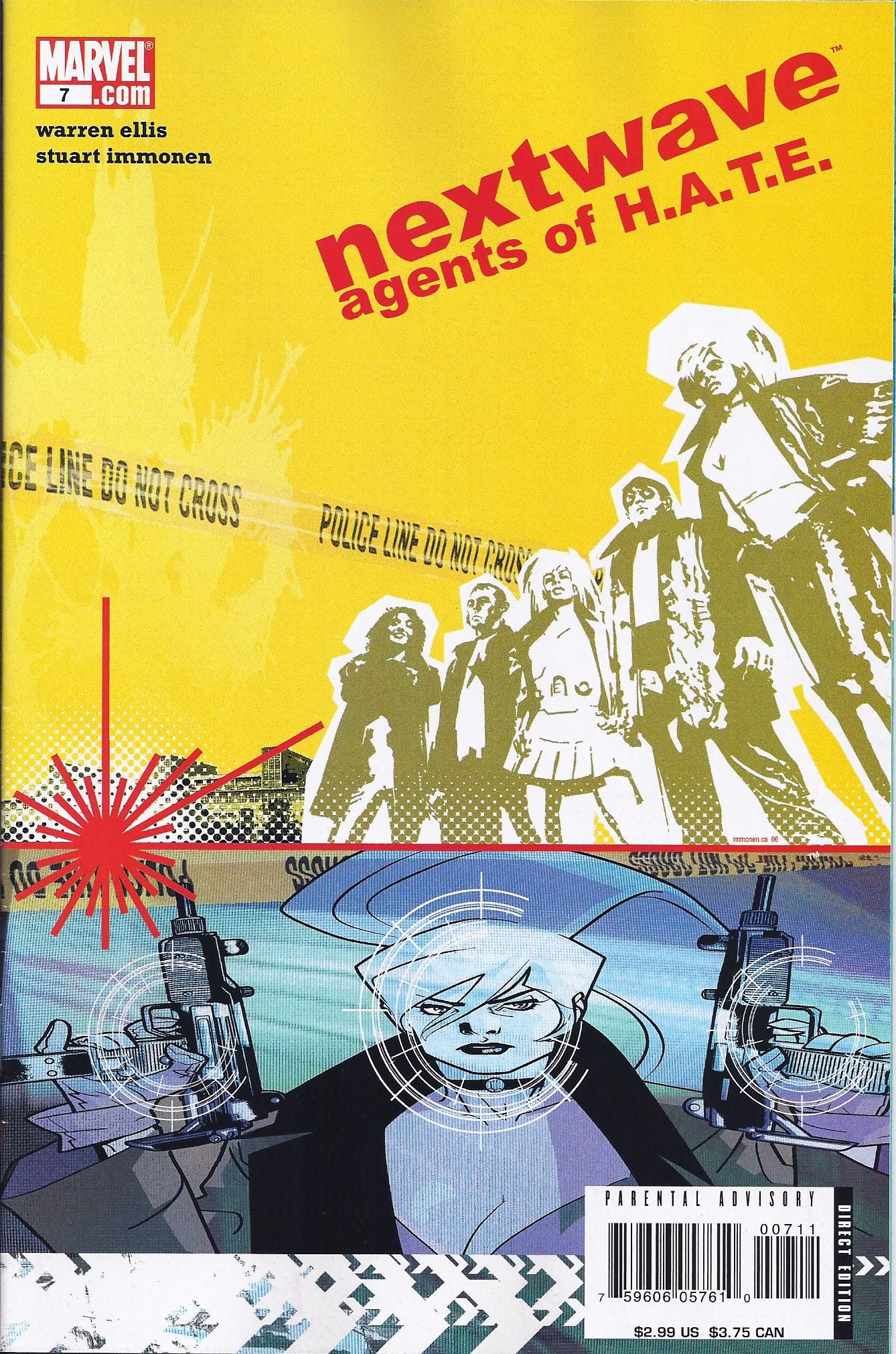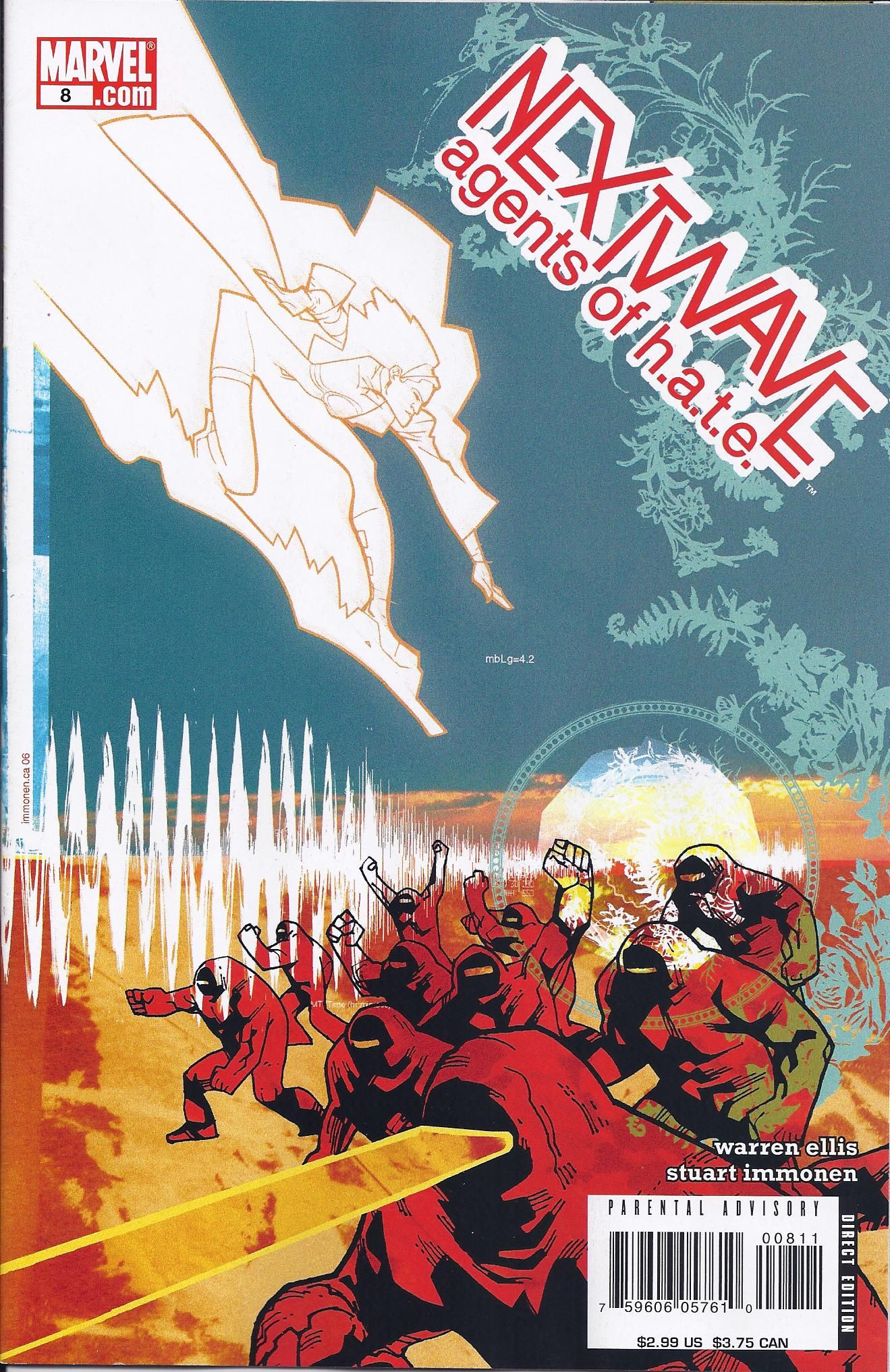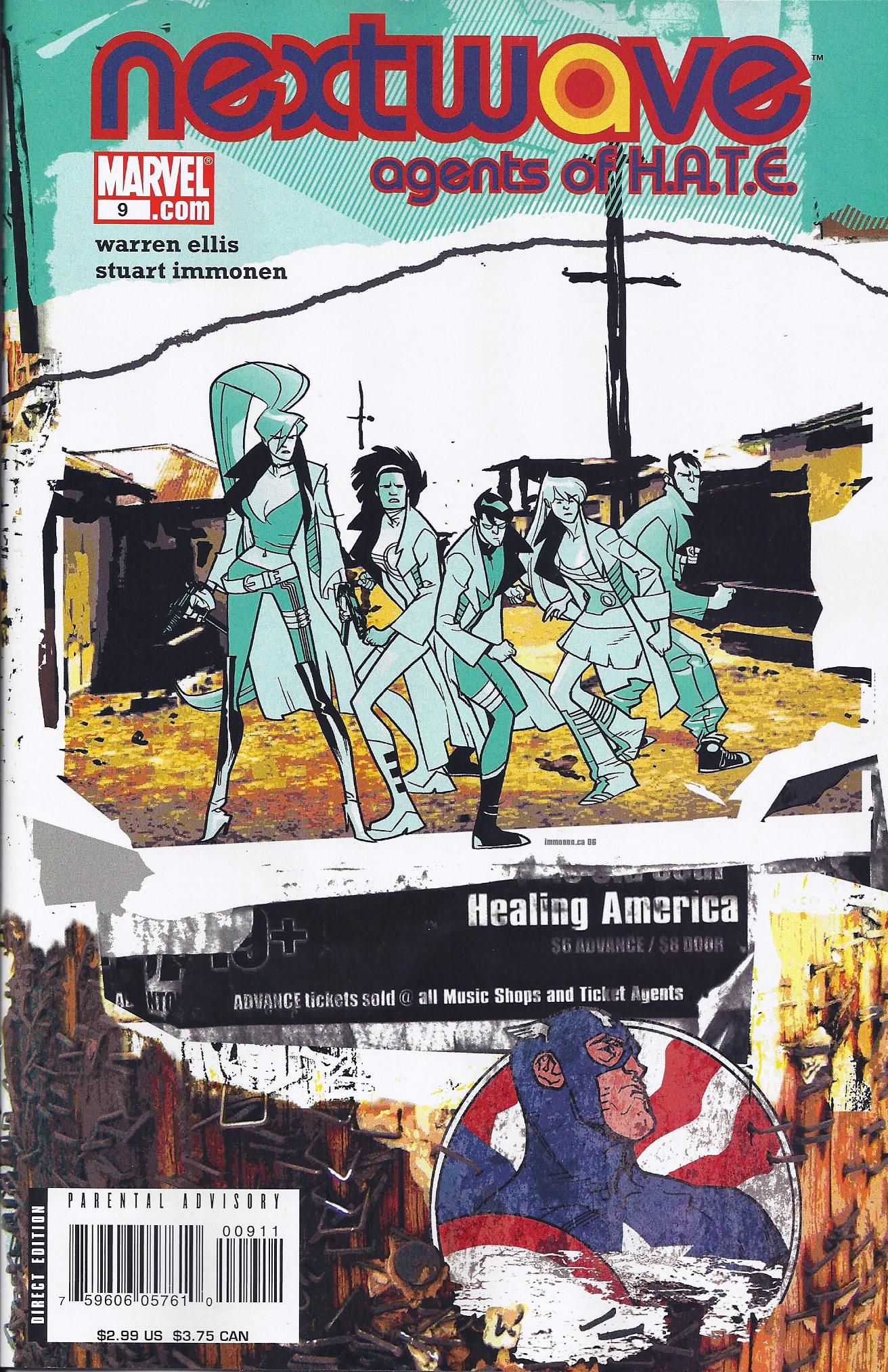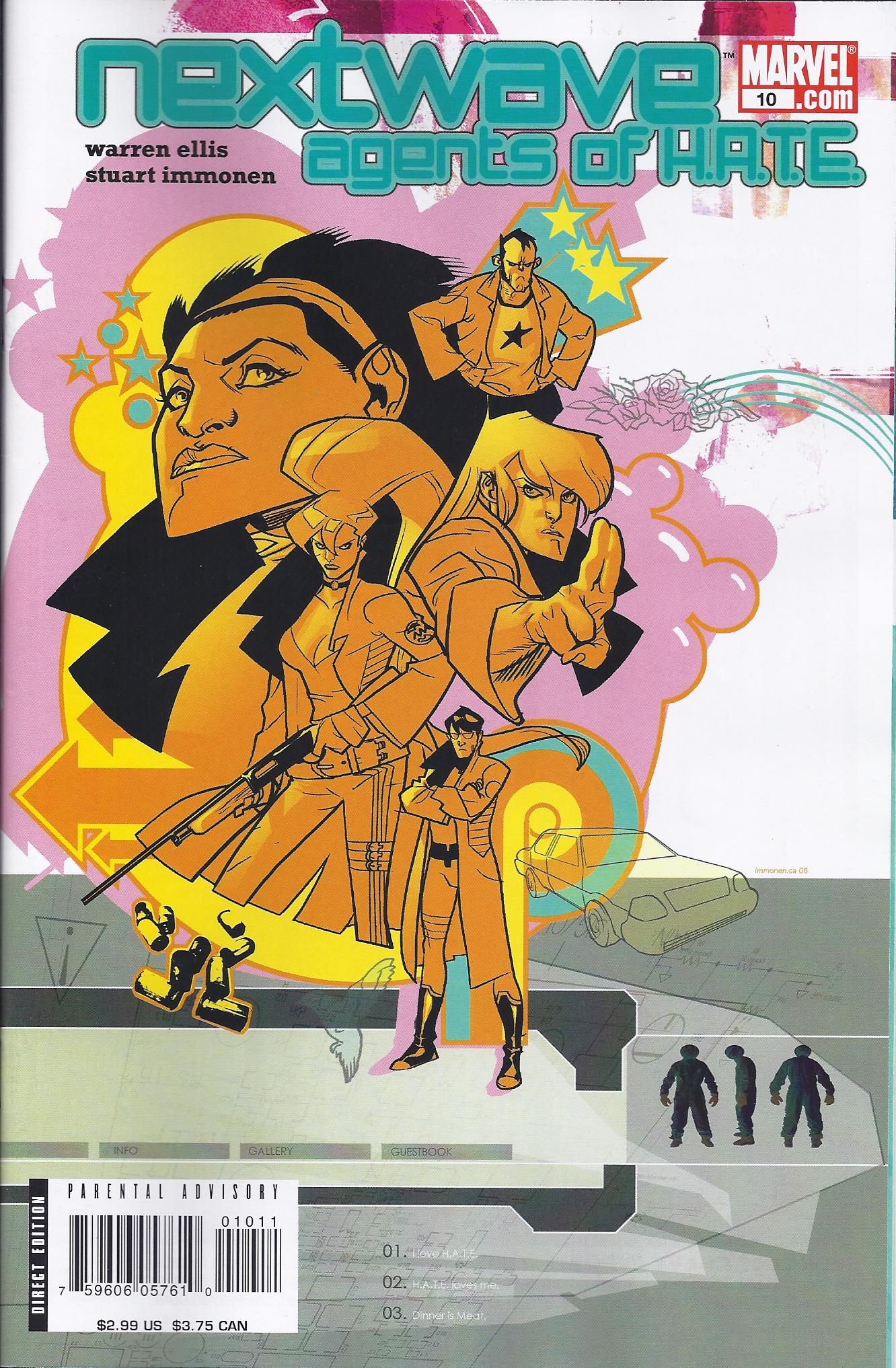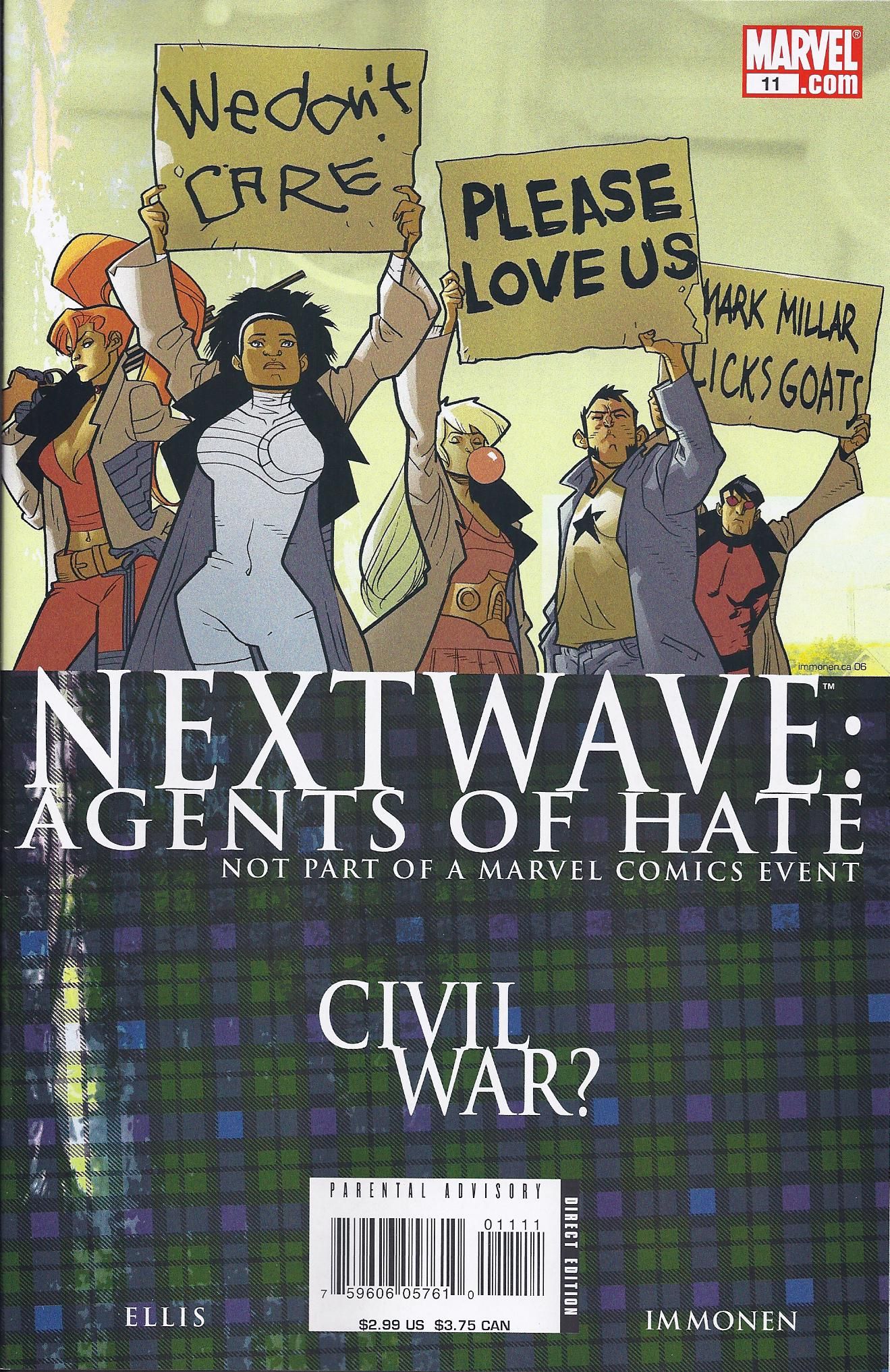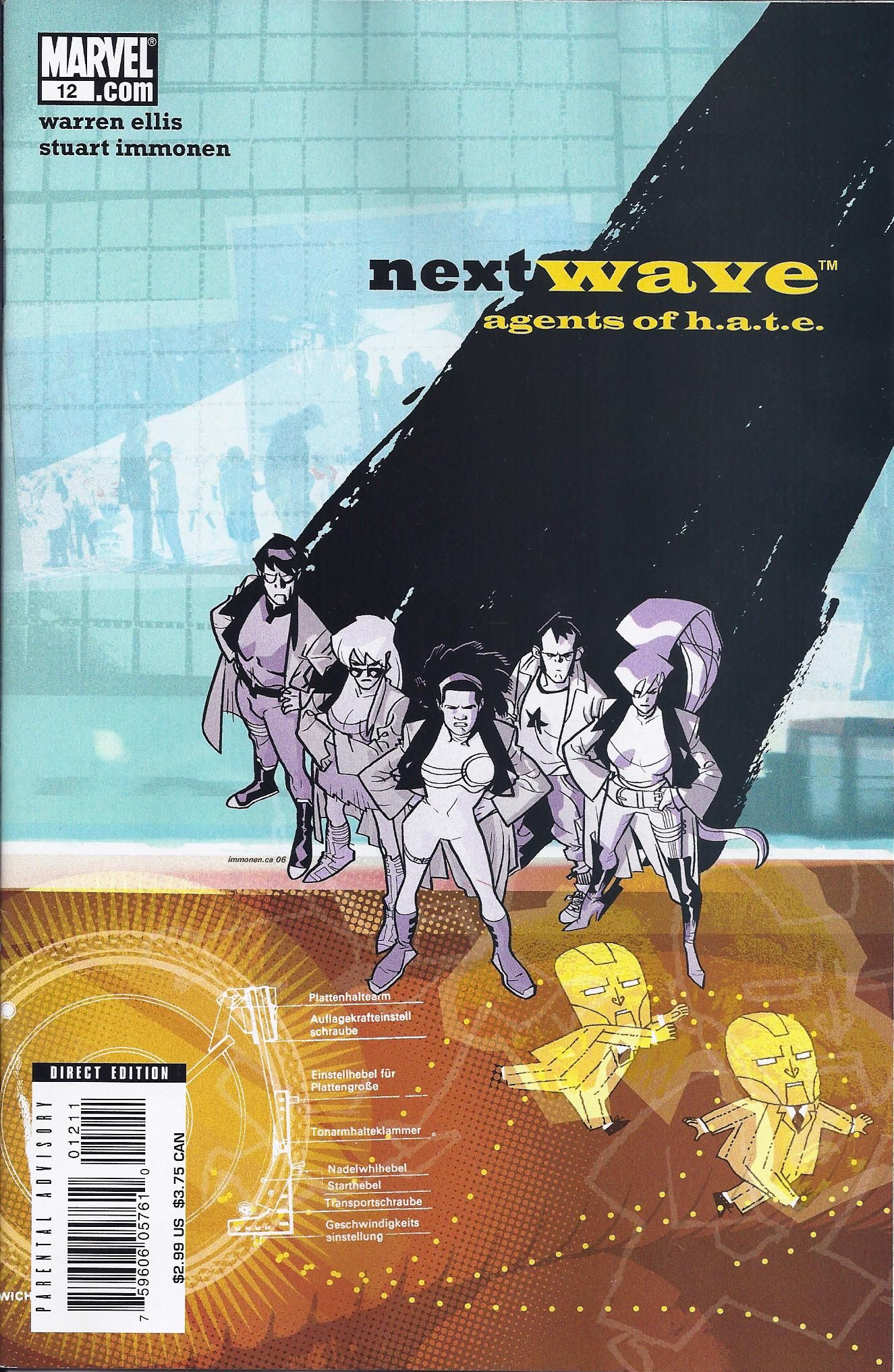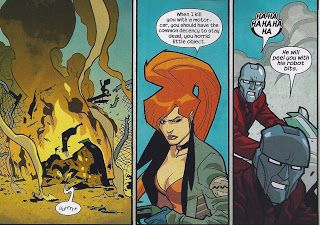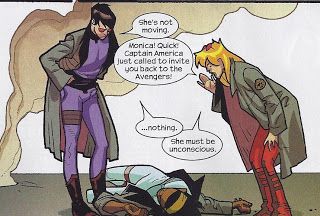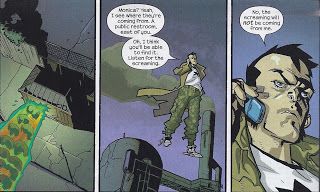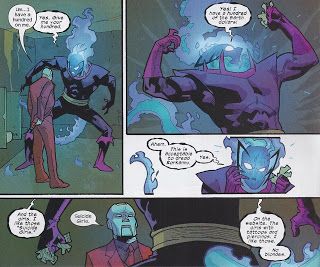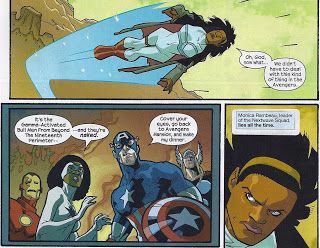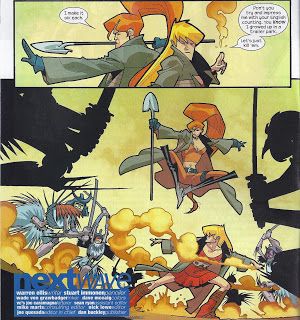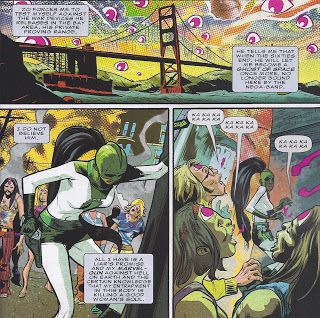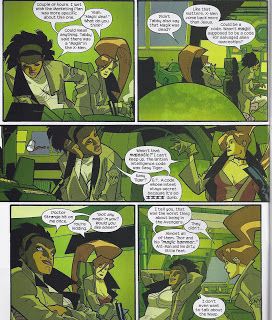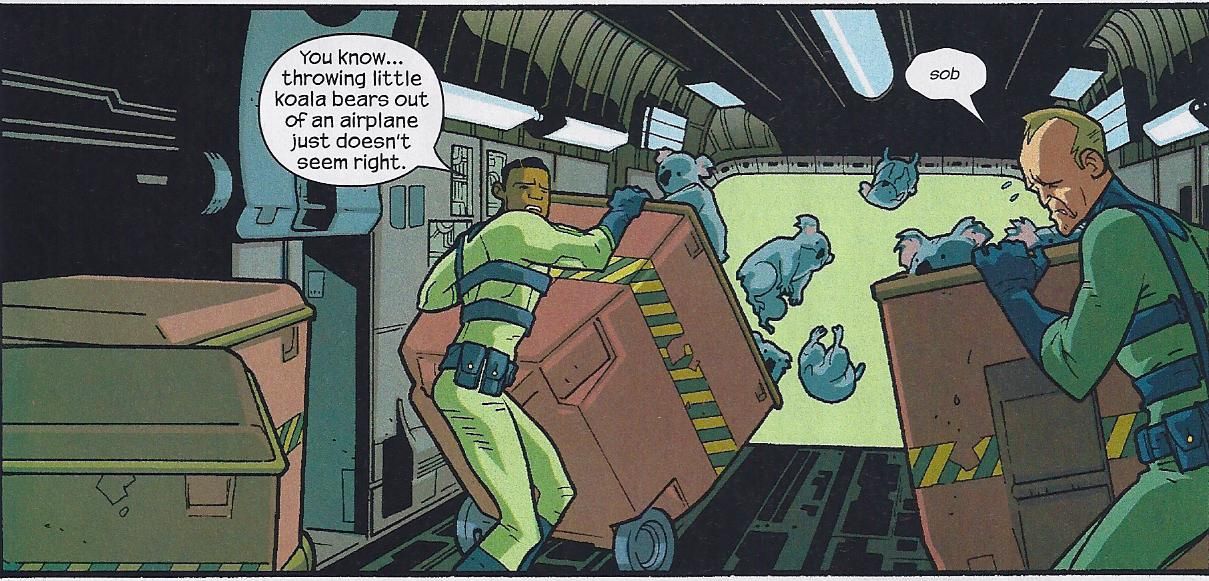SPLODE!
Nextwave: Agents of H.A.T.E. by Warren Ellis (writer), Stuart Immonen (penciler), Wade von Grawbadger (inker), Dave McCaig (colorist), Paul Mounts (colorist, issue #7), Chris Eliopoulos (letterer, issue #1), and Joe Caramagna (letterer, issues #2-12).
Marvel, 12 issues (#1-12), cover dated March 2006 - March 2007.
(I don't write about the covers of this book, but they're pretty cool, aren't they?)
Some minor SPOILERS below, but not the big stuff! And, of course, you can giganticize the panels, because if you haven't read this, you need to see some of the humor contained within!
In the annals of comics, there are serious books, and there are unserious books. And then there's Nextwave, which is one of the more insane comics to come out in the past twenty years.
That it came out from Marvel is amazing, especially as 2006 was after the Bill Jemas Era, when Marvel seemed willing to publish a lot of completely wacky comics. That it might have lasted longer is even more amazing (according to the story, Marvel wanted to pull Immonen off the book and put him on Ultimate Spider-Man and Ellis didn't want to continue without Immonen, so apparently it wasn't necessarily sales that caused its cancellation). Nextwave is an unusual comic in that it's a perfect storm of a writer, artist, and tone producing a comic that is far greater than what you might expect. Unlike some other humorous comics I've written about, like The Heckler, this series really has nothing much on its mind. Ellis isn't making any subtle statements about anything except perhaps how ridiculous superheroes are (which isn't that trenchant an observation, mind you). Basically, Nextwave is Ellis going batshit insane on a comic and Immonen matching him perfectly. It's almost pure plot, and it's dazzling.
Ellis embraces the goofiness of superheroes with his basic plot: The Highest Anti-Terrorism Effort (H.A.T.E.) put together a superhero squad to fight bad guys. Before the series begins, one of the heroes finds a marketing plan put together by the Beyond Corporation©, which funds H.A.T.E. The Beyond Corporation© was once called S.I.L.E.N.T., a terrorist cell, and now they're working hand-in-glove with the anti-terror group.
The marketing plan calls for testing of weapons of mass destruction on American soil, so the heroes go rogue and stop the various product tests. The leader of H.A.T.E., Dirk Anger (not a Nick Fury analogue at all!) chases them down. Simple, right?
The heroes are collected from the Z-list of Marvel supers and Ellis's feverish imagination: Monica Rambeau, who once led the Avengers but was no longer a top-of-the-line hero in 2006; Elsa Bloodstone, the premier monster hunter in the Marvel Universe and subject to mini-series in the early 2000s where the covers looked like this; Tabitha Smith, the mutant once called Boom-Boom, who can make things explode; Aaron Stack, the robot also known as X-51, whose personality gets a nice makeover in this series; and the Captain, Ellis's own character, created in response to all the ridiculous comic book characters with "captain" in their name. Ellis takes these bottom of the barrel characters and makes them his own, tying them nicely into established Marvel continuity (especially Monica, who in the early issues often talks about how things were when she was in the Avengers, a running gag that pisses everyone else off) but turning them into wonderful if Ellisian creatures (which, I admit, might not be everyone's cup of tea). And then he turns them loose on many wacky beasties that thrive in the Marvel Universe, which they dispatch with a lot of funny dialogue and maximum carnage (the good kind of maximum carnage, not this kind).
Each mission lasts two issues, and eventually the team finds the head of S.I.L.E.N.T. and, well, does its thing. I really don't want to ruin who the head of S.I.L.E.N.T. is, because it's pretty awesome.
One of the great things about Nextwave is that there's really no underlying theme or motif - it's just superheroes beating up bad guys, done with great wit and stupendous art. Ellis makes the book remotely serious only a few times - the first is in issue #8, when Elsa knows what the Mindless Ones are because her father raised her to recognize every single monster. She remembers the trauma of her upbringing briefly before going back to killing monsters. At the end of the book, the sarcastic narrator tells us: "It had been a long, strange night for the Nextwave Squad. One of them had finally had his turn at winning. One of them even had something approaching a Character Moment. You can be damn sure we won't let shit like that happen again."* Then, in the brilliant issue #10, when Forbush Man zaps the Nextwavers into alternate realities within their minds, Ellis ramps up the emotion so that we see how trapped they all are in their despair. But that is undermined by the fact that they're inside their own heads and by the way they get out, which is both laudatory and insulting to Tabby. Other than that, Ellis refrains nicely from allowing the book to get dragged down into mawkishness.
Despite their insecurities - Monica's nagging belief that the Avengers didn't take her seriously; Elsa's bad memories of her childhood; Tabby's rage at being treated like a dumb blonde; the Captain's insecurity - they enjoy beating the hell out of bad guys, and so they do.
* The only really annoying thing in Nextwave is that Ellis likes to curse and Marvel doesn't like to print them, so we get curse words grawlixed by skulls, which is kind of funny but still distracting. I wish writers would not use curse words when they know the company is going to obliterate them, because it takes me right out of the narrative and reminds me how stupid this censorship is. Because what I really want is for Marvel and DC to allow cursing in books, like Nextwave, that are certainly not appropriate for children. IT HAS A "PARENTAL ADVISORY" WARNING ON IT, FOR CRYING OUT LOUD! If you're already "warning parents," why not allow the cursing? Motherfucking shit-fuckers, is what they are.
And what bad guys! I don't want to ruin all the fun surprises that are in store for you when you read this comic, but here's just a partial list of the bad guys Nextwave fights: Fin Fang Foom (whose defeat is oddly tender, if still not terribly serious); Mac Mangel, the corrupt cop who has been turned into a giant robot; killer koalas;
Rorkannu, Lord of the Dank Dimension (and his Mindless Ones); S.I.L.E.N.T.'s various superteams, some of which are modeled after existing teams (including Ellis parodying his own creation, The Authority); some "Not Brand Echh" characters, including Forbush Man; and, from the glorious double-page spreads in issue #11, Elvis M.O.D.O.K.s that shoot hamburgers, dinosaurs with Cyclops' vision powers, and giant monkey Wolverines. This unrelenting cavalcade of awesomeness becomes tedious only in issues #5 and 6, when Dirk Anger has lured the team to a "war garden" where the Beyond Corporation© grows its Human Resources bad guys (affectionately called "broccoli-heads" because that's how much sentience they possess) and throws all sorts of bizarre monsters at them (including the killer koalas). These two issues almost feel as if Ellis is trying way too hard, and I considered dropping the book if more issues were like this. Happily, issue #7 returned to the twisted humor of the first four issues, with less desperate attempts at dazzling the reader and more hilarious dialogue, and the book picked up again. Issue #11, which also feels like an attempt to be way awesomer than we can stand, is better than the earlier ones, mainly because of the way Immonen draws it. Plus, by that time Ellis was wrapping things up, so the story had a bit more forward momentum.
Ellis also has a grand time making fun of the Marvel Universe as a whole. Of course, Dirk Anger and his ridiculous devices (for intance, the giant telephone receiver he wears on his head, which he refers to as a "etheric loop recall televocometer") are part of the fun, but I'm talking about the way the superheroes themselves recall their experiences with more serious parts of the Marvel U.
Fin Fang Foom becomes an object of ridicule for his purple underpants and lack of genitals, a far cry from, for instance, his appearance in Legion of Night (remember Legion of Night?). (I suppose I should point out that this appearance has been retconned into a clone of Fin Fang Foom, because Marvel can't even let one of their rampaging dragons die in the regular continuity.) Ellis postulates what happened to the other 50 robots Dr. Stack went through before he got to Aaron, X-51. The Captain's "secret origin," while not an event from another comic, is done in as silly a way as possible to show how silly superhero origins can be. Aaron Stack's adventures with the Celestials don't end well. Monica remembers the chauvinism she faced in the Avengers. Tabby flashes back to her time with Cable, whom Ellis savages mercilessly. Rorkannu (NOT Dormammu, mind you, although they look suspiciously similar) digs the Suicide Girls, because why not? Monica and Elsa discuss Captain America's sexuality. The New Paramounts (the Not Brand Echh team) are created from the detritus of the Marvel U.
All of this makes the Marvel Universe a slightly more absurd place, but also a place that feels more real - yes, lots of people have superpowers and monsters abound, but Fin Fang Foom is horny and nobody takes Monica seriously because she's a woman and the Celestials aren't as otherworldly as we might expect. It's a weirdly humanizing book, from which a good deal of its humor springs.
A great part of the glory of Nextwave's success comes from Stuart Immonen, whose work on this book is stunning. I believe this was the first time Immonen unveiled his new, more angular, more cartoony style (after his smoother and more "realistic" work on such comics as Final Night, Shockrockets, and Superman: Secret Identity), and it's amazing how excellent it is. He's marvelous on the action sequences, choreographing the fights with wonderful precision, and his attention to detail is tremendous. His design work is hilarious and inspired, from the wild villains that Nextwave fights to the armor that Dirk Anger wears, which is a parody of ridiculous superhero armor everywhere. Immonen's facial expressions sell the book, though - Ellis writes dialogue that needs an artist with a good handle on how to draw faces, and from Dirk Anger's crazed expressions to Aaron Stack's bemused looks when he contemplates "the fleshy ones" (his term for humans), Immonen delivers. He parodies the famous panel of Vision crying wonderfully, and he manages to make Tabby both ditzy and deeper than Ellis writes her. He shifts beautifully from Rorkannu acting like a stereotypical Marvel villain to an abashed loser caught in an embarrassing situation. When Ellis decides to turn the Mindless Ones into the cast of West Side Story (yes, it's true), Immonen manages to make it work.
Immonen creates a bunch of new superheroes when S.I.L.E.N.T. attacks Nextwave in issue #9, and he has a ton of fun with "The Surgery" and "The Vestry," even though I would have loved to have seen his version of Slightly Creepy Policewoman, who never shows up.
By far, however, Immonen's two most impressive (and famous) achievements in this series are when Forbush Man sends the members of Nextwave into their own minds in issue #10 and the double-page spreads in issue #11. Monica is sent to a nightmarish San Francisco of December 1967, and Immonen draws it like a bad acid trip, with McCaig adding psychedelic coloring to the sky and Immonen coming up with all sorts of creepy visuals. Immonen draws the Captain's "world" in his older style, with smoother lines and lighter inks (von Grawbadger inks Immonen with a heavy line throughout this comic, which helps a great deal with the style) and more lurid McCaig colors. He draws Elsa's vision in the style of Mike Mignola (even Caramagna's letters are in that style), which isn't a bad idea as Elsa is hunting monsters. It's amazing how effortless his shift in styles looks, and I doubt if many artists could have pulled it off. Meanwhile, in issue #11, Ellis has the squad fight through The Beyond Corporation's© crazy clones, and Immonen is simply superb. I'd show you some of it, but, well, Brian already has (and there's a spoiler in the comments section, if you read those).
While it would have been nice to see more issues of Nextwave, twelve issues feels about right.
Ellis has a way of burning out on titles, and Immonen couldn't have kept up the pace he was on, and Marvel would have had to get the right artist to fill in for him. Nextwave is almost perfect as it is - even issues #5 and 6, the weakest of the run, fit in better with the overall story than they do as a single episode - and needs nothing more, really. It's an example of what superhero comics could be like, if the companies and writers had more onions to take them and run with them. Wouldn't that be a better world?
Obviously, with a series this tremendous, I'm not the first person at this blog to write about Nextwave. If you're still not convinced that you should own this, check out Bill Reed's paean to the comic's genius (yes, Bill used to post almost every day at this very blog!) and, more recently, Kelly's testimonial (both of these posts contain some spoilers in the comments section, too). Yes, Nextwave is so good it even impresses the young lady who hates comics! You can't beat that! After reading all of these posts, you can go buy the giant-sized paperback collecting all twelve issues and enjoy the heck out of them. It's what Ellis and Immonen would want you do!
As always, the archives are open for your perusal. Who doesn't want to buy more comics?

